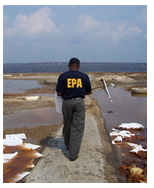Response to Hurricane Katrina
ALERT
Boil Drinking Water
If your water may not be safe, bring drinking water to a rolling boil for 1 minute to kill water-borne diseases.
More information | en español
Hurricane Recovery
Getting help
Giving help
Missing people
General information
All -![]()
Other Agencies
10/17/05
 EPA has conducted more than 3,100 incident responses since deploying emergency response personnel following the destruction left by Hurricane Katrina along the Mississippi and Alabama coastline. An incident response is defined as an investigation of a National Response Center Report, contacting facilities, and reporting hazmat debris while conducting land or water assessment in the affected areas.
EPA has conducted more than 3,100 incident responses since deploying emergency response personnel following the destruction left by Hurricane Katrina along the Mississippi and Alabama coastline. An incident response is defined as an investigation of a National Response Center Report, contacting facilities, and reporting hazmat debris while conducting land or water assessment in the affected areas.
Assessment and Removal Team Activity
EPA is operating under three divisions that were formed to address Hancock (Division A), Harrison (Division B), and Jackson, Mississippi Mobile and Baldwin, Alabama (Division C) counties, which are the most affected areas along the coast. The U.S. Coast Guard (USCG) is serving as liaison between EPA and the three divisions. Coastal MS experienced storm surge flooding of 18 to 22 feet above normal tide levels and significant rainfall amounts during Hurricane Katrina.
Division A – Hancock County, Miss.
Teams conducted operations in the Port Bienville, Pearlington, Waveland and Edwardsville areas. They also continued recovering material from debris fields.
An EPA team assessed a vehicle maintenance facility in Hancock County and observed several drums on the property, some of the drums were leaking waste oil, and there was sheen on a nearby water body. The team coordinated clean up at the facility.
Division B – Harrison County, Miss.
Two teams were deployed to observe debris removal operations in Biloxi and Gulfport, Miss., and remove previously located items.
Additionally, two teams conducted assessment of debris removal operations in Harrison County and hazmat field collection forms were distributed to points of contact for debris removal.
Division C – Jackson County, Miss., and Baldwin and Mobile Counties, Ala.
Teams continued to monitored segregation of hazmat from debris piles in Jackson County.
Air Monitoring
The Air Monitoring Support Team is collecting PM 2.5, PM 10, with metals analysis and asbestos at three permanent sampling sites in Pascagoula, Gulfport and Stennis Air Bases. Additionally, the VOC, SVOC, carbonyl, and hexavalent chromium samplers are being collected at these sites.
The team is also operating three sites near larger burn area. They are sampling for PM 2.5, PM 10 and asbestos. The team has collected a total of 66 PM 2.5, 66 PM 10 and 37 asbestos sample, along with 17 VOC, 17 SVOC, 17 carbonyls and 17 hexavalent chromium samples. All Air data results will be coordinated with EPA’s Emergency Response Team.
NPL Sampling Team
Field sampling for the NPL study is completed and the data was sent to the laboratory for analysis. Once the data is received, it will undergo Quality Assurance Review and the results will be reported to project leaders.
Water Systems
An EPA mobile drinking water laboratory, stationed in Gulfport has processed more than 1,188 drinking water samples and continues to analyze new samples each day.
The Waste Water Treatment situation continues to improve. In Mississippi, the Delisle Waste Water Treatment Plant is now operating normally and East Biloxi is still operating primary treatment only. The state of Alabama reported that Dauphin Island's Wastewater Treatment plant is now operating at limited capacity. This means that all municipal wastewater treatment facilities in Alabama and Mississippi are now considered to be operational.
Lift Stations Branch
EPA has been tasked by FEMA to assist numerous towns along the Mississippi Gulf Coast to temporarily solve municipal wastewater problems as a result of Hurricane Katrina. These towns have included Bay St. Louis, Biloxi, Gautier, Gulfport, Laurel, Long Beach, McClain, Moss Point, New Augusta, Ocean Springs, Pascagoula, Pass Christian, Picayune, Waveland, and three separate water authorities. Tasks have focused on clearing collection systems filled with sand and debris, installing bypass pumps to substitute failed pump stations, and a variety other complex tasks. This work has reduced the amount of wastewater exposure to the public and disaster relief individuals while also helping city officials evaluate their systems and provide them with the time needed to respond with permanent replacements and repairs.
• Emergency Fuel Waiver for AL, FL, LA, MS
![[logo] US EPA](../gif/logo_epaseal.gif)